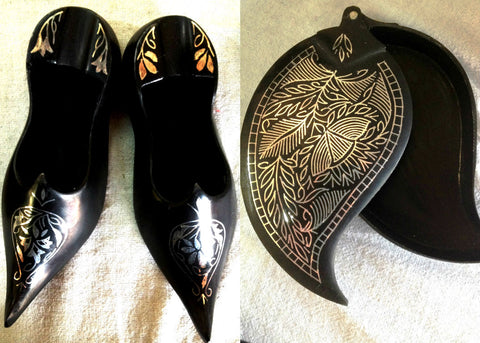The origin of the name Bidri craft is from the Bidar district of Karnataka. Having originated in Persia, this craft entered Indian Territory back in the 14th century and flourished under the Bahamani Dynasty in Bidar. While gold and silver was traditionally used as inlay over copper or steel for the Persian art form, Bidri work adopted the use of zinc as the primary metal.
The Bidri art form has been given the ‘Geographical Indication’ tag as a mark of certification that states that this particular work of art can be made only in the Bidar region and nowhere else. It is not only the beauty, history, and production technique that lend a mark of significance to this work of art but an ingredient used in the work that is indigenous to the region- soil obtained from the Bidar Fort. A form of black soil, it is an important component for all forms of Bidri art. This can be put down to its special chemical properties, created due to the fact that the soil has remained away from rain and sunlight for many a century. This soil is primarily used as an oxidizing agent.
It is very hard to specify the reason that makes this soil inside the Bidar Fort so unique. The members of the community of Bidri craftsmen have various theories on the subject. A popular claim has to do with the practice of making copper coins in a section of the Fort during the reign of the Sultans in the area. Powdered metal would seep down into the soil, resulting in this oxidizing property being developed over the years. Some others believe that the practice of storing weapons in underground chambers inside the Fort is responsible for this phenomenon.
How are Bidri Handicrafts prepared?
The process of making products in accordance to the Bidri art form involves a number of steps. These are detailed as under.
- Casting the alloy: A mould is prepared out of a mix of resin, castor oil, and soil. Molten metal alloy of zinc and copper, taken in the ratio of 16:1, is poured into this mould. Based on the product design, various metal castings may have to be welded together in order to get the final single product.
- Buffing: The rough surface of the mould is filed in order to give it a smooth texture
- Drawing the design: In order to obtain a temporary black hue, copper sulphate is applied on the shiny surface. This way, the craftsmen find it easier to draw neat, clear designs. A metal stylus is used for etching the design on to the surface of the mould
- Engraving the design: With the help of a chisel, the design is carved out
- Inlaying: Inlay work depends on the design and is of two types- wire work or sheet work. Wires or sheets of pure silver are hammered on to the engraved grooves with precision. The surface is then buffed and smoothened so that there is no extra silver jutting out. Once the product has been completely filed, the entire surface regains its white appearance. At this point, the silver inlay work is hardly visible
- Oxidizing: This is something unique to the Bidri art form. Soil from the Bidar Fort is mixed with boiling water and ammonium chloride in order to get a solution. On applying this solution to the surface of the product, the zinc-copper alloy turns jet black but the silver engravings remain unaffected. This black color is permanent and there is no risk of it fading away
The end result of all this effort is a product with striking silver highlighted against a black background.
Products of Bidri craft can be purchased online from CraftsandLooms.com. Buy Bidri Handicrafts online made by our craftsmen from Bidar.


